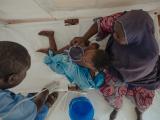The rate of waterborne disease outbreaks caused by Legionella in drinking water has been increasing, according to a study released today in the Centers for Disease Control and Prevention's (CDC's) journal Morbidity and Mortality Weekly Report (MMWR).
Researchers from the CDC and the Environmental Protection Agency (EPA) analyzed data from 32 waterborne-disease outbreaks related to drinking water reported by 14 states in 2011 and 2012. The outbreaks were responsible for at least 431 illnesses, 102 hospitalizations (24% of cases), and 14 deaths.
Sixteen (50%) of the outbreaks involved exposure in hospitals or healthcare settings, 4 (13%) to exposure in hotels, and 3 (9%) to exposure in camps or cabins. Twelve (86%) of the fatal cases were associated with healthcare settings.
More than half (56%) of the outbreaks involved drinking water that used surface-water sources.
Legionella's role in outbreaks
Legionella pneumophila was implicated in more than half (21, or 66%) of the outbreaks, 111 (26%) of the cases, 91 (89%) of the hospitalizations, and all 14 deaths. Contamination of plumbing systems and untreated groundwater appeared to be the culprits. .
Outbreaks related to Legionella contamination of surface and groundwater systems have made up a steadily increasing proportion of drinking water–associateddisease outbreaks, having comprised only 33% of total outbreaks as recently as 2009-10.
Although Legionella outbreaks are typically associated with inhalation of aerosolized water particles (witness the current outbreak in Bronx, NY, associated with contaminated water in cooling towers), drinking-water systems can also harbor the bacteria. Greater source monitoring of groundwater and surface water systems, disinfection with chlorine or other agents, and stringent monitoring of disinfectant levels are needed to curb bacterial growth in potable water.
Non-community sources
When researchers looked at individual cases rather than outbreak numbers, they saw a slightly different picture, one that underscored the difficulty of regulating and monitoring non-community drinking water sources.
Although non-community sources of drinking water (eg, private wells, water provided in campgrounds) were implicated in only five outbreaks, they were responsible for 222 of the waterborne-disease cases. More than half (61%) of these cases were caused by groundwater contamination.
Though Legionella caused most of the outbreaks and associated severe illnesses, researchers found that 53% of cases were caused by other gastrointestinal pathogens, such as Shiga toxin–producing Escherichia coli (62%), norovirus (32%), Shigella sonnei (24%), and Pantoea agglomerans (13%). These cases highlight the importance of maintaining chlorine levels to reduce fecal contamination of drinking water systems.
Contamination of non-community drinking water systems caused a significant rise in waterborne disease cases from 2009-10 (15% of cases) to 2011-12 (52% of cases). The CDC recommends full implementation of the EPA's Ground Water Rule and Revised Total Coliform Rule to reduce fecal contamination in drinking water sources but also recognizes that the EPA cannot regulate private wells and septic systems.
Environmental water exposure
The CDC and EPA researchers also analyzed data from outbreaks related to environmental exposure to water during the same time period in a separate study today in MMWR. Data submitted by 11 states revealed that 18 outbreaks comprising 280 cases had occurred from 2011 to 12, leading to 67 hospitalizations and 10 deaths.
As in the study of drinking water, Legionella was responsible for all deaths, four of which occurred after exposure in healthcare facilities. Legionella contamination of environmental water systems was associated with the majority of outbreaks (15) and cases (254).
Forty cases were related to contaminated water systems in hotels, while six were associated with hospitals or long-term care facilities. Decorative fountains were implicated in three of the five outbreaks with known sources of contamination.
Because Legionella can cause significant illness and death, especially in the elderly and people with compromised immune systems, the CDC recommends more stringent monitoring and disinfection of environmental and drinking water contamination, particularly in healthcare facilities.
See also:
Aug 14 MMWR study on drinking water
Aug 14 MMWR study on environmental water
Oct 2006 EPA Ground Water Rule
Dec 2014 EPA Revised Total Coliform Rule




















